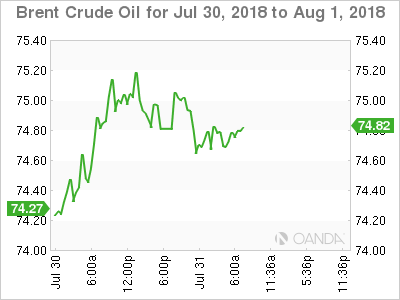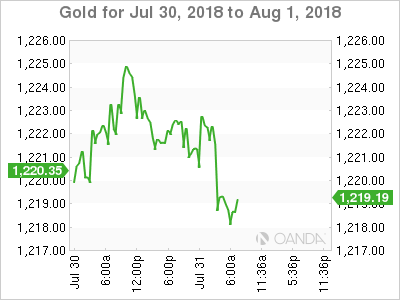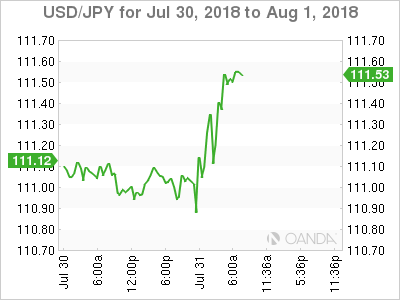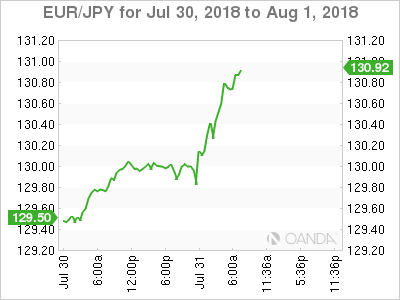Tuesday July 31: Five things the markets are talking about
Sovereign government bonds prices have rallied overnight as the Bank of Japan (BoJ) again committed to keep its ‘ultra-loose’ monetary policy intact.
As expected, Japanese policy makers tweaked some policies, but signalled rates to stay low for an ‘extended period of time.’
In respect to the long-term rates, the BoJ reiterated that it would continue to buy JGB’s to keep their 10-year yield at about +0%, but added that ‘while doing so, the yields may move upward and downward to some extent mainly depending on developments in economic activity and prices.’
Elsewhere, global equities have been trading somewhat mixed as corporate earnings reporting continues – all market eyes will be on Apple’s Q2 results today after the close.
From a central bank monetary policy perspective, next up will be the Fed (Aug 1) and the Bank of England (Aug 2). Capital markets will be looking for confirmation that U.S policy makers plan two more interest-rate hikes before year-end, while in the U.K, Governor Carney is expected to hike interest rates by +25 bps despite ongoing Brexit worries.
Commodity prices are under pressure after China’s manufacturing PMI’s fell this month (51.2 vs. 51.5 m/m) as the first-round of U.S tariffs begin to have an impact.
On tap: U.S personal spending and income data for June will be released. On Friday, it’s U.S non-farm payrolls (NFP), which is expected to show a healthy labor market with +193K new jobs, and an unemployment rate slipping back to +3.9%.
1. Stocks mixed results
Global stocks are broadly steady, but mixed overnight, after U.S tech share losses yesterday.
In Japan, the Nikkei share average ended flat, rebounding from a one-week low after the BoJ tweaked its monetary policy settings, but refrained from making any radical moves. The benchmark Nikkei inched up +0.04%, while the broader Topix fell -0.84% as bank shares fell on profit-taking after the rate decision.
Down-under, Aussie shares found support Tuesday, mostly supported by BHP. The S&P/ASX 200 rallied +0.03%, holding atop of its multi-year highs, to close out for a fourth consecutive month of gains. In S. Korea, the Kospi inched higher, closing out the month +0.08% in the ‘black.’
In Hong Kong, the Hang Seng index ended down overnight, following the U.S tech sector lower. At the close of trade, the index was down -0.52%, while the Hang Seng China Enterprises index closed -0.2% lower.
In China, stocks closed higher, aided by gains in real estate and energy firms, while the market response to the country’s manufacturing data has been relatively muted – the data clearly reports a slowdown in economic momentum. The blue-chip CSI300 index ended +0.1% higher, while the Shanghai Composite Index closed +0.3% firmer.
In Europe, regional bourses are trading mixed in a range bound trade, while in the U.S stocks are set to open in the ‘black’ (+0.2%).
Indices: Stoxx600 +0.1% at 391.2, FTSE +0.1% at 7711 DAX +0.1% at 12811, CAC-40 flat at 5492, IBEX-35 +0.5% at 9905, FTSE MIB +0.6% at 22080, SMI +0.2% at 9183, S&P 500 Futures +0.2%
2. Oil prices drop on oversupply worries, gold unchanged
Oil prices fell overnight, with Brent futures set for their biggest monthly loss in two-years, as oversupply concerns rose on reports that OPEC’s output rose in July to its highest for 2018.
September Brent crude futures fell -25c, or -0.3% to +$74.72 a barrel after rising nearly +1% yesterday. U.S West Texas Intermediate crude futures (WTI) are down -24c, or -0.3% at +$69.88 a barrel, after rising more than +2% on Monday.
Note: For the month, Brent futures are set to drop -6%, while WTI futures are set to decline -5.8%.
A Thomson Reuters survey showed that OPEC increased production by +70K bpd to +32.64M bpd in July, the most this year – to offset the loss of Iranian supply as U.S sanctions have already started to cut exports from the world’s third-largest producer.
Ahead of the U.S open, gold prices are steady, trading within a tight range as the market adopts a ‘wait-and-see’ approach ahead of the Fed’s two-day monetary policy meeting, commencing today. Spot gold is up about +0.1% at +$1,222.15 an ounce, while U.S gold futures are -0.1% lower.
3. Euro zone bond yields edge up after inflation beats expectations
Eurozone government bond yields are edging higher this morning, after preliminary data showed that inflation was higher than expected in July.
Headline consumer inflation accelerated to +2.1% from +2.0% in June, while core-inflation rose to +1.3% from +1.2% in June.
Germany’s 10-year government Bund yield has backed up to +0.44%, while other euro zone bond yields have come off their lows, rising about +1 bps across the board.
This Thursday, the Bank of England (BoE) is expected to hike +25 bps. However, market expectations are looking for a split vote of perhaps 6-3 in favour of a rate rise – some members are likely to continue favouring waiting to see how the data develops.
Note: The market is pricing in an almost +90% odds for a hike.
Elsewhere, the yield on U.S 10-year notes has declined -2 bps to +2.95%, the lowest in a week, while in the U.K, the 10-year yield has declined -2 bps to +1.343%, the biggest fall in more than a week.
4. Dollar’s mixed results
The yen (¥111.51) is a tad weaker after the BoJ’s policy decision overnight. The bank has stressed a ‘prolong period of extremely low rates’ or in other terms further ‘policy stimulus’ in its first-ever forward guidance. Technically, the statement is encouraging for long-term investors to consider adding to their ‘carry-trade’ positions.
Elsewhere, a plethora of mixed European data (see below) is supporting the EUR (€1.1724). Nevertheless, the pair remains confined to its tight summer trading range. This morning’s mixed data will do little to persuade the ECB to move away from its current stimulus objectives.
5. Eurozone economy slows further
Data this morning showed the eurozone’s economy slowing further in Q2, as exports and business confidence both weakened on trade relations concerns.
Eurostat said that compared with Q1, the eurozone’s GDP was +0.3% higher, the weakest expansion in two-years, and year-over-year, it was +2.1% higher.
Note: The U.S/E.U growth differential is the widest in four-years. Stateside, economic growth was +4.1% q/q.
Consumer confidence is expected to rebound if there is progress in talks to resolve trans-Atlantic tensions.
Higher oil prices are another obstacle. The ECB confirmed last week that it would proceed with plans to end QE in December, but a ‘lengthening period of weaker growth may make it reluctant to hike rates next year.’
Other data this morning released showed the annual rate of inflation rose to +2.1% in July, further above the ECB’s target and that the unemployment rate across the eurozone was steady at +8.3% in June, but the number of people without work rose slightly for the first time in 12-months.
















